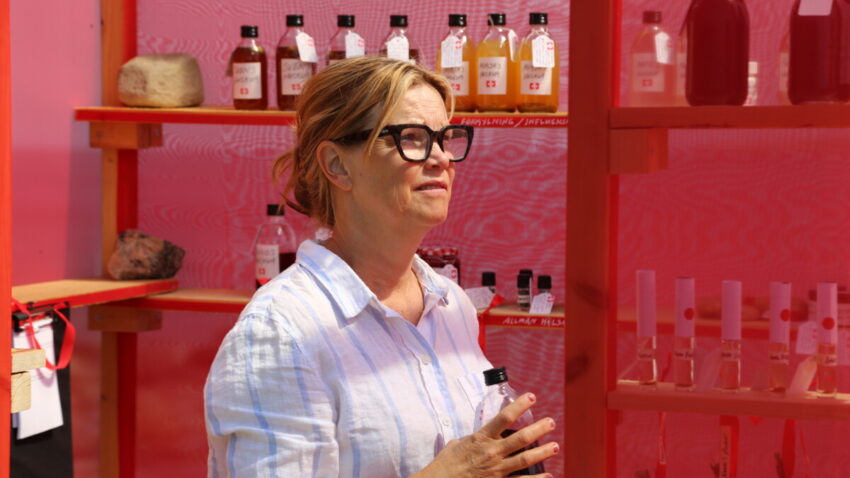by Martha Albertson Fineman
The following essay appeared in the catalog for Social Pharmacy, a social art piece by Jody Wood that features “a site-specific exchange of health remedies.“

Jody Wood’s innovative artistic method involves selecting significant social issues or practices to explore and combining the empirical insights of the social scientist with the critical and creative vision of the artist. This critical and constructive interdisciplinary approach has the potential to yield unique and productive insights into those social practices that we may otherwise take for granted. As an artist, her task is not to merely represent or conceptually exemplify reality, but to also reveal transformative possibilities. She seeks to directly engage those encountering her work in this creative process, bringing them into the work as participants rather than mere observers or onlookers. In doing so, she compels us to not only see, but to care about these social practices and the effects they have on our individual and social lives.
In some of her earlier work, Jody addressed pressing issues of societal failure, such as homelessness. Among the significant consequences exposed were the stigma and exclusion imposed on certain members of society as a result of their housing status. The need for compassion and effective social policy in regard to housing for the disadvantaged and dispossessed is certainly important and this project successfully raised those issues. However, while it may have generated feelings of sympathy and concern, the focus on only the situation of some also permitted the viewer of the piece to stand separate and apart: to perceive what is a universal need in terms of “us” (the successful and housed) verses “them” (the unsuccessful and unhoused). The need for shelter is something that all humans share, the critical emphasis on the status of homelessness and the situation of only some deprived individuals obscured the implications of this universal shared reality.
This current piece, The Social Pharmacy, moves beyond a focus on a marginalized segment of population to speak to the dependency and vulnerability that consistently marks every human life. Our vulnerability arises as a result of the fact that every individual body can and will become ill, be injured or find itself otherwise in need of healing. This reality necessitates that we will be dependent on social institutions and relationships throughout our lives. Such a universal perspective, which begins with recognizing the fragility of the body, seems particularly appropriate in this pandemic era. Covid-19 has had tremendous individual and societal consequences that seem to elude both medical and political resolution. The pandemic teaches us (once again) that many problems are beyond individual control and that expectations of self-sufficiency and autonomy are limited at best. The current situation also should make it clear that dependence on social institutions and relationships is inevitable, not exceptional, but normal and routine. A failure to recognize this reality and collectively and individually respond can have devastating destructive consequences for individuals and for societies. We must find and implement society-wide responses to this collective threat to our well-being.
Jody’s artistic intervention by creating a Social Pharmacy also directs us to consider an even more expansive lesson when it comes to social needs: the process of recognizing and responding to human vulnerability and dependency can have positive effects and generate creative opportunities on both an individual and societal level. On an individual level, the project gives us the opportunity to learn and grow from absorbing the stories of those who produced and shared their home-made remedies. These stories can provoke us to “discover” (or uncover) our commonalities with those individuals and generate feelings of recognition and compassion.
In addition, by engaging with these stories, we collectively can create a sense of connection that can tie us together as a community. This process of connecting through engagement is what Jody refers to as “performing collaborative caring,” which, while offered outside of formal institutional structures, hopefully will have implications for how each of us assesses the design and operation of those formal institutional structures going forward. An important contribution of any artistic work is the questions it raises as it challenges the ways in which we had formerly perceived the world. One compelling question taken from this exhibit of collective caring might be: do our healthcare and social welfare systems respond to the realities of human vulnerability and dependency, or are they distorted by an excessive emphasis on the myths of independence and individual autonomy and self-sufficiency? Another might be to ask how we might make those systems better, more responsive to our shared vulnerability and dependency.
Emphasizing the need for community and collective caring does not diminish the status of the individual. An important aspect of this exhibit is that it offers us a lesson about the significance discrete actions can have on the collective welfare. The request that an individual leave behind their own home remedy in the Pharmacy when taking one made by another could be viewed as no more than a “transactional” and individualistic exchange. However, the interpretation more in line with the communalist message the Social Pharmacy coveys is that each individual has been given the opportunity to contribute to the common good, to respond to the collective need. Far from being an obligation, those contributions both express and affirm the individual’s membership within and value to society.
The Social Pharmacy brilliantly reminds us that one important function of art is to provoke critical thought and generate discussion. In this way, art can provide a vital framework for individual and collective assessment of the society in which it is generated and which it ultimately reflects.
Martha Albertson Fineman
Robert W. Woodruff Professor of Law
Founding Director, Vulnerability and the Human Condition Initiative
Emory University, Atlanta Georgia, USA